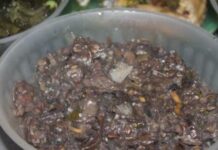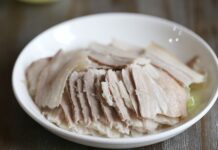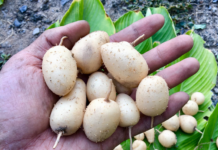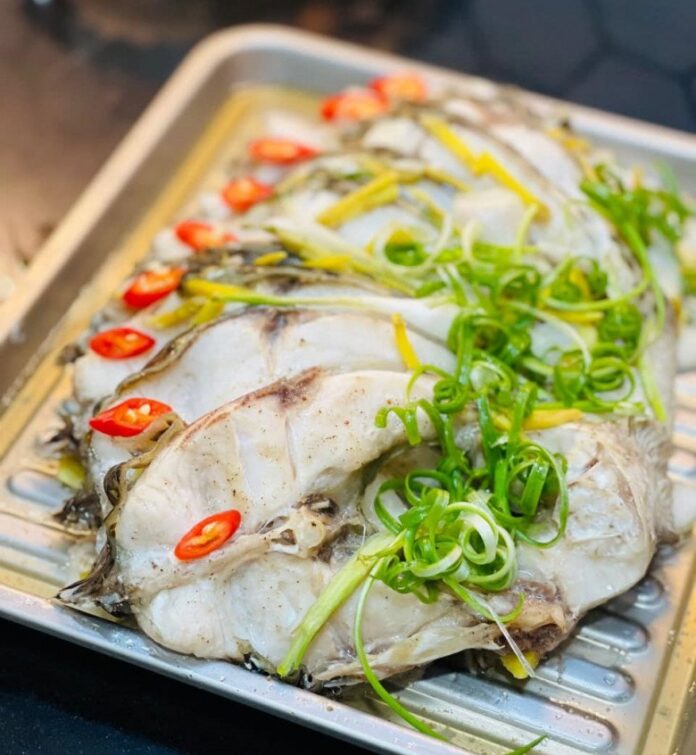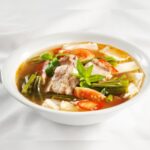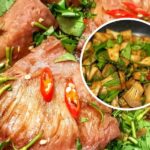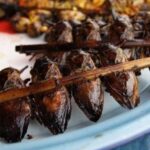Ingredients:
– 1 tilapia.
– Onion, ginger root.
– 30-50ml beer.
– Fresh chili, scallion.
– Marinade: 1 tablespoon fish sauce, 1 tablespoon soy sauce, 1 tablespoon oyster sauce, 1 tablespoon sugar, 1 teaspoon ground pepper.
Instructions:
– Scale and gut the tilapia, removing any black membrane. Rinse thoroughly.
– Cut off the tail and head. Using a knife, slice the body into portions without cutting all the way through.
– Mix the marinade and pour it over the fish, massaging it both inside and out.
– Line a steaming tray with a layer of ginger and onion.
– Place the fish on top and arrange it attractively.
– Add another layer of shredded ginger and sliced onion.
– Pour in 30-50ml of beer.
– Steam the fish for 20 minutes at 100 degrees Celsius.
– Garnish with scallions and fresh chili, and serve.
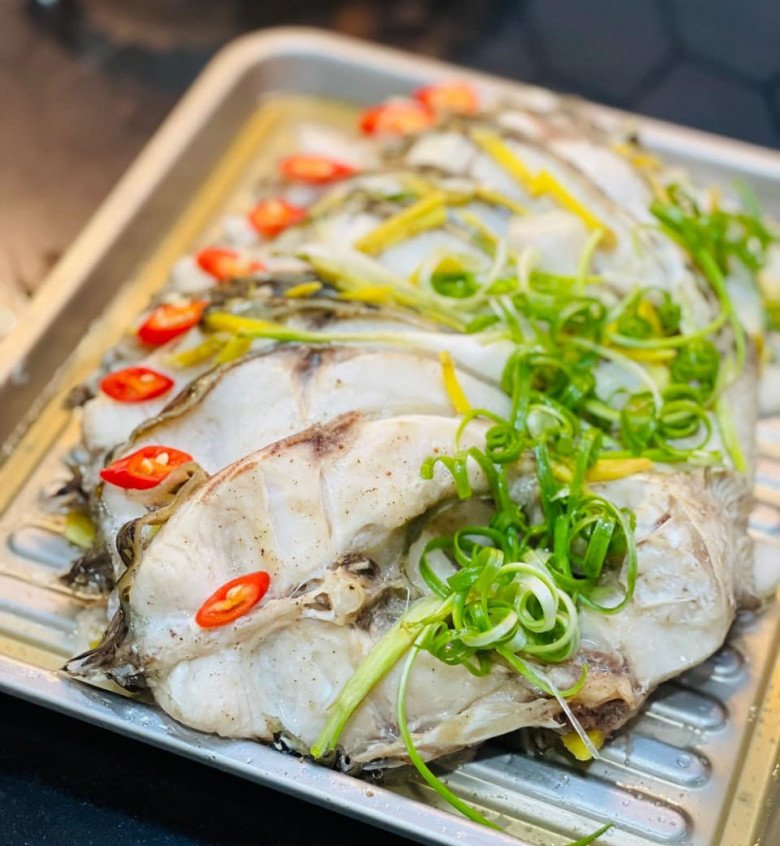
2. LEMONGRASS PORK RIBS
Ingredients:
– Pork ribs.
– Lemongrass stalks.
– Thyme.
– Bottled barbecue sauce (available at supermarkets).
– Garlic, chili.
– Asparagus, carrots.
– Vegetable butter.
– Seasonings: fish sauce, seasoning powder, pepper, chili powder, chili sauce, white sesame, honey.
Instructions:
– Rinse the ribs and parboil them with ginger and salt to clean. Drain and marinate with barbecue sauce, honey, chili sauce, seasoning powder, fish sauce, chili powder, pepper, and minced garlic. Refrigerate overnight or for at least 3-4 hours to let the flavors permeate.
– Place the ribs in an air fryer and cook at 160 degrees Celsius for 20-30 minutes.
Then, add a few slices of lemon and lemongrass stalks on top.
Halve the garlic bulbs and arrange them on a tray. Continue cooking at 190-200 degrees Celsius until the ribs are golden.
– Sauté minced garlic with vegetable butter, then use this to mix with the asparagus and carrots. Add a pinch of pepper and salt to taste. Place the vegetables in the air fryer, setting the temperature to 180 degrees Celsius. Cook the asparagus for about 7-8 minutes and the carrots for about 15 minutes.
– Sauté minced garlic and shallots, then add the rib marinade and simmer. Add some toasted sesame seeds to complete the dipping sauce.
– Plate the ribs with the roasted garlic, asparagus, carrots, and a small bowl of the rib sauce for dipping.
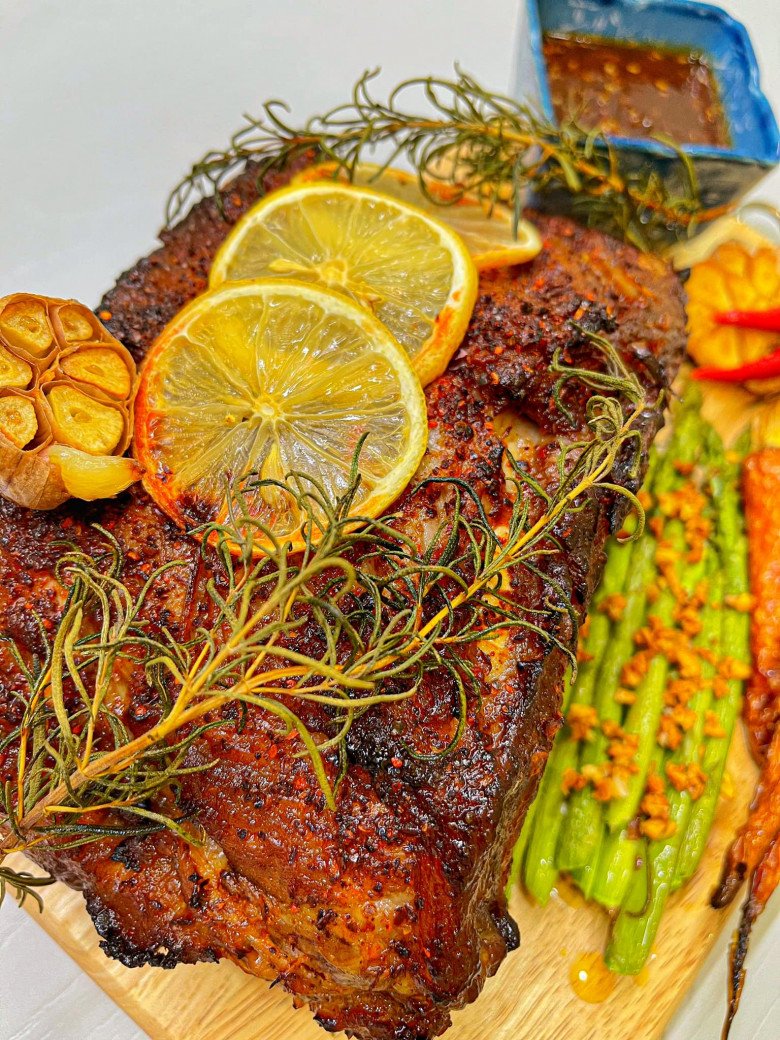
3. HỘI AN-STYLE CHICKEN RICE
Ingredients:
– 1 young hen, approximately 1.2-1.5kg
– Fresh coconut water
– Red cabbage, carrots, onion, coriander, basil
– Scallions, shallots, garlic, chili, lime
– Quail eggs
– Seasonings: seasoning powder, salt, pepper, fish sauce, oyster sauce, turmeric powder, vinegar, sugar.
Instructions:
Step 1: Braise the Chicken in Coconut Milk
– Clean the chicken and rub it with ginger and white wine to eliminate any odors.
– Apply a mixture of 3 teaspoons of seasoning powder, 1 teaspoon of ground pepper, 1 teaspoon of fish sauce, 1 teaspoon of oyster sauce, 3 teaspoons of minced garlic, chili, and shallots, along with 1 teaspoon of turmeric powder, all over the chicken’s skin. Marinate for 30 minutes to an hour to let the flavors absorb.
– Sauté the shallots, then add the chicken and pour in coconut milk until it covers about half of the chicken. Simmer on low heat, turning the chicken occasionally to ensure even cooking and absorption of flavors.
Once cooked, chop the chicken into bite-sized pieces.
Step 2: Cook the Rice
– Render the chicken fat with minced garlic, then mix it with the rice, adding turmeric powder to give the rice a beautiful color (saffron can be used as an alternative to achieve a yellow hue without the turmeric flavor).
– Cook the rice in a rice cooker with water as usual.
Step 3: Prepare the Quail Egg Stir-Fry
– Steam the quail eggs for 5-10 minutes. Marinate the chicken gizzards with a dash of fish sauce, pepper, seasoning powder, and minced garlic and shallots. Sauté this mixture first, then add the eggs and stir-fry quickly for 5-10 minutes. Season to taste, then turn off the heat and toss in sliced onion and scallions.
Step 4: Make the Chicken Salad
– Shred the red cabbage.
– Shred the onion and soak it in ice water to make it crisp and reduce its pungency.
– Cut the carrots into thin strips and marinate them with 1 tablespoon of sugar, 1/2 tablespoon of salt, and 1 tablespoon of vinegar for 30 minutes in the refrigerator.
– Shred the chicken breast and mix it with the red cabbage, carrots, onion, coriander, basil, fried shallots, salt, pepper, and lime juice.
Serve the rice on a large plate, surrounded by the chicken pieces, chicken salad, and quail egg stir-fry.
This colorful and aromatic dish is sure to impress your family and guests!
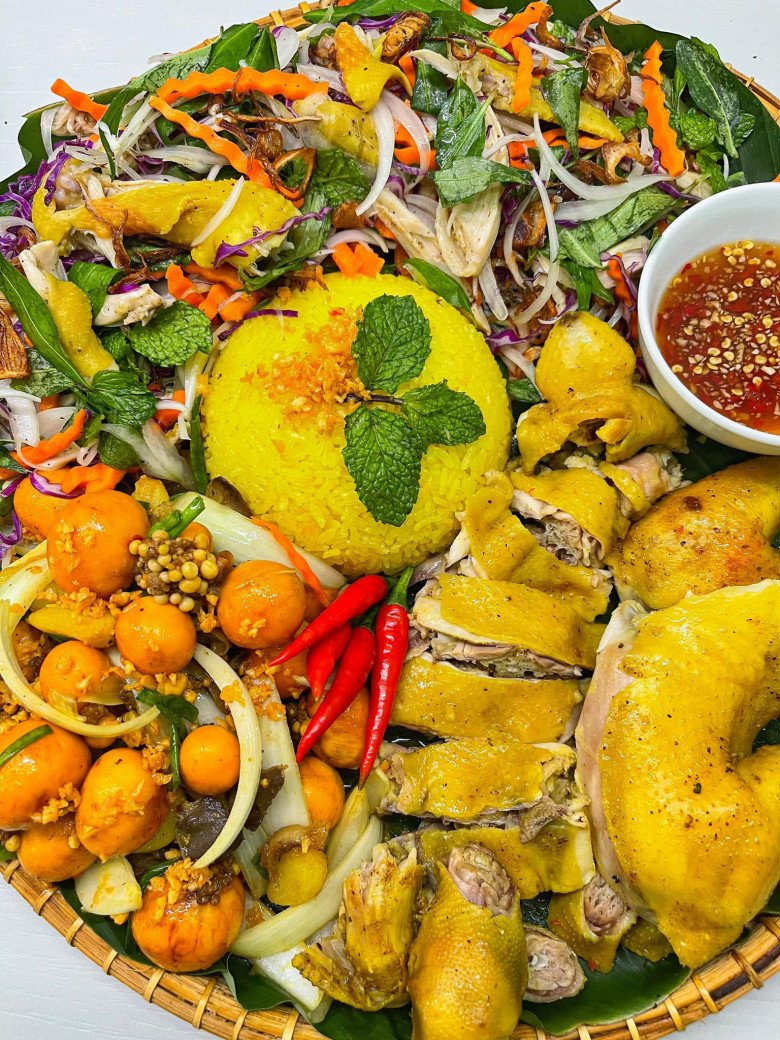
4. ROAST DUCK
Preparation:
1 duck, 2 lemongrass stalks, 2 shallots, 1 clove of garlic, 1 piece of galangal
1 teaspoon of oyster sauce, 1 teaspoon of syrup/honey/molasses + pepper + licorice root
Instructions:
– Peel and clean the lemongrass, shallots, garlic, and galangal, then grind them into a paste.
– Mix the paste with 1 teaspoon of oyster sauce, 1 teaspoon of syrup/honey/molasses, pepper, and licorice root.
– Choose a duck weighing less than 2kg. Clean and parboil it for 15 minutes (this ensures even cooking and prevents dryness). After parboiling, rub the duck with the spice paste and let it marinate for 30 minutes.
– Place the duck in an air fryer. (When roasting, remove the spices and leaves to avoid burning; these can be baked separately at 150 degrees Celsius for 10 minutes to create crispy, aromatic garnishes). If using an air fryer with a rotating spit, cook the duck for 30-40 minutes.
For a traditional air fryer, follow these steps:
– Step 1: Place the duck upside down and cook at 160 degrees Celsius for 10 minutes to tighten the skin.
– Step 2: Turn the duck over and cook at 160 degrees Celsius for another 10 minutes to brown the underside.
– Step 3: Increase the temperature to 180 degrees Celsius and cook for 5 minutes. Baste the duck with the remaining marinade.
– Step 4: Cook at 180 degrees Celsius for another 3 minutes and baste again. Final step: Increase the temperature to 200 degrees Celsius and cook for 2-5 minutes, or until the duck is a deep golden color. This method takes longer but yields tender, juicy meat.
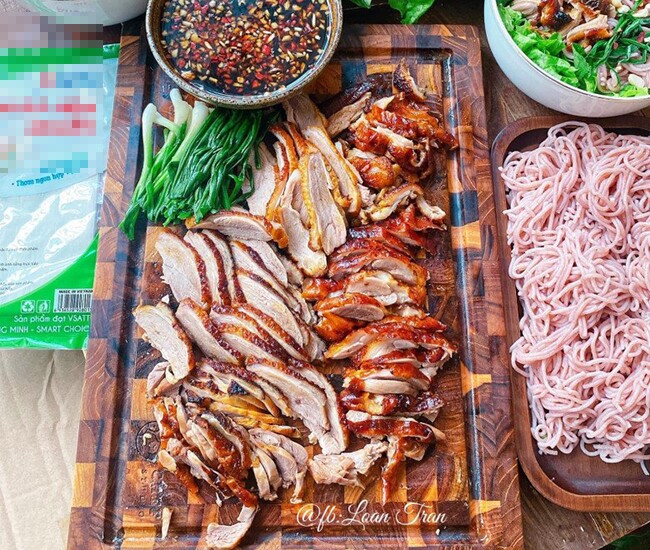
5. SHRIMP AND PORK RICE ROLLS
Ingredients for Shrimp and Pork Rice Rolls or ‘Thang’ Rolls:
– Large river shrimp or shrimp: 250 grams (alternatively, use shrimp or prawns)
– Pork belly: 300 grams
– Vietnamese pork sausage: 150 grams
– 3 quail eggs.
– Rice vermicelli or rice paper.
– Scallions (use the longer outer leaves)
– Lettuce, basil, mint, coriander.
– Shallots, garlic, sugar, fish sauce, pepper, chili, vinegar, lime.
Instructions for Making Shrimp and Pork Rice Rolls:
Step 1: Reduce the Rice Wine
In a pan, combine the rice wine with palm sugar and ginger. Simmer over low heat until the liquid reduces and thickens. Remove from the heat and let it cool.
Step 2: Fry the Shrimp
Clean the shrimp and marinate them with 1/2 teaspoon of salt, 1 teaspoon of sugar, and 1 teaspoon of rice wine for a few minutes. Place the shrimp in a pan and cook until they turn red, stirring occasionally. (For shrimp or prawns, remove the shells and devein after cooking, then halve them lengthwise).
Step 3: Boil the Pork
– Rinse the pork belly and boil it with a few smashed shallots. Once cooked, plunge the pork into cold water to firm the meat and improve its texture. Slice the pork into thin strips about 3cm long.
Step 4: Fry the Eggs
Beat the quail eggs with a pinch of salt and a dash of rice wine. Heat a pan, adding a teaspoon of oil and wiping off the excess. Pour in a small amount of egg mixture and quickly spread it into a thin layer. Fry until dry, then flip and remove from the pan. Repeat with the remaining egg mixture—you should get about 6 thin egg crepes. Cut these into small pieces.
Step 5: Prepare the Remaining Ingredients
– Slice the sausage into thin, small pieces suitable for rolling.
– Blanch the scallions and plunge them into cold water to retain their green color.
– Cut the vermicelli into 3cm lengths.
– Wash and prepare the lettuce, basil, mint, and coriander.
Step 6: Assemble the Rolls
– Place the ingredients on a lettuce leaf, adding a dab of reduced rice wine in the center.
– Carefully roll the lettuce around the fillings, ensuring a tight wrap without tearing the leaf.
Position the shrimp and pork on the outside and secure the roll with a length of scallion, creating an attractive presentation.
Step 7: Prepare the Dipping Sauce
– Cut the carrot, daikon, and cucumber into small cubes. Mix them with equal parts salt, sugar, and vinegar.
– For the dipping sauce, combine 3 tablespoons of fish sauce, 2 tablespoons of sugar, 1 tablespoon of lime juice, 5 tablespoons of water, and minced garlic and chili to taste. Adjust the seasoning as needed.
Serve the rice rolls with the dipping sauce for a delicious, refreshing, and impressive dish, perfect for entertaining guests.
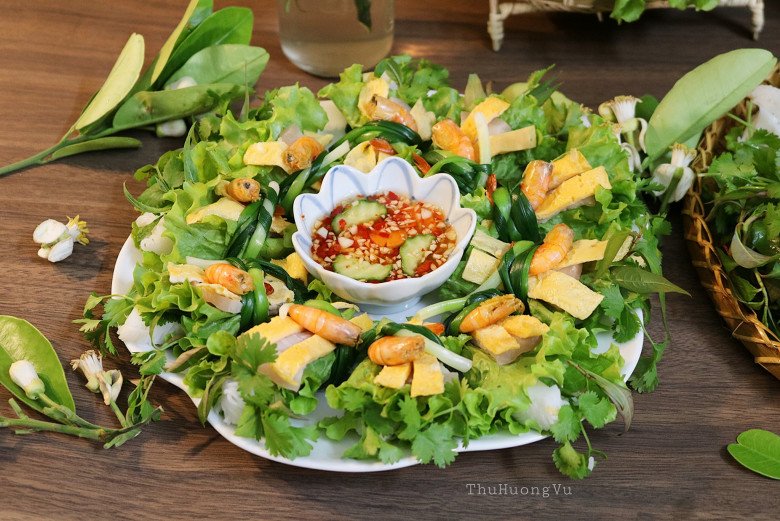
Good luck!











